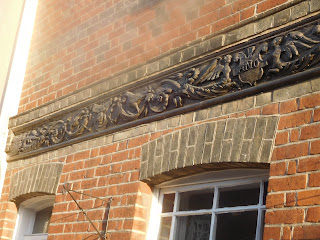East Street 1851 Census
1851 was the year of the Great Exhibition in London: a spectacular showcase of the industrial might of Great Britain. Queen Victoria was taking a year out from child-bearing, having already borne seven children. France had gone through another revolution in 1848. In Ireland the population had been devastated by the potato famine and by mass emigration. And what of Coggeshall? You might think that little would have changed in this quiet rural backwater, but you would be wrong - Coggeshall was one of the most heavily industrialised towns in Essex in 1851.
The 1851 Census is quite different in character to the 1841 Census. For the first time people were asked to record their marital status, place of birth and how each person recorded related to the Head of the household. These extra details give a much clearer picture of family structures in quite surprising ways.
East Street in 1851
The census records 288 people living in 67 households, 97 of whom were sixteen or under. Only about a third of those households had remained the same as in 1841. It is not clear why this should be, although the preponderance of rental properties might have led to greater turnover. People may simply have moved to the next street in Coggeshall.
Women's Work
The most common female occupation in 1851, apart from keeping house, was "Tambour Worker" ie making Coggeshall lace. Twenty young women, from the age of seven, were recorded in this way. There was also a female"lace agent" in the village as well as a male employer. Work at the silk mill had taken off, with whole families employed at winding and weaving. Velvet weaving was done by both sexes.
Alongside the sixteen servants and four housekeepers, several women were recorded as nurses. One fourteen year old girl was set down as School Teacher, reflecting the expansion of education. A visitor to the village, along with her nine year old daughter, was employed in plaiting straw. This was a sign of things to come: plaiting straw for hats and baskets became a major trade here.
Masters, journeymen and apprentices
The 1851 census asked those who employed others to state the numbers, describing themselves as "Master". In fact, a system reaching back to the medieval trade guilds was used: Master, journeyman and apprentice. The term "journeyman" reveals that an apprenticeship has been served and that the person is a paid employee. Eight men are recorded as journeymen in trades such as blacksmith, tailor, grocer and carrier. White collar professions are beginning to appear: bank manager, curate, general practitioner, inland revenue officer, manager of the gas works, tambour manufacturer.
Scholars
The village had a boys' grammar school set up by Sir Robert Hitcham's Trust in 1666. There had been a National School here since 1811. However, the 1851 census records younger children as "Scholar", even at very young ages. Some are said to be "Scholar at home". Others are set down as "Sunday scholar" perhaps because the child in question was at work on weekdays. This certainly became an issue at Hall's silk mill where children employed in winding silk would work a half day and go to school for the other half. Eight year olds were expected to manage this.
Family Structures
The new information presented reveals that almost half the households in East Street were not nuclear families with two parents and their children. About a dozen households were headed by a widow or widower, in the latter case often with an unmarried sister or sister-in-law as housekeeper. Siblings might be living together, or single women living alone. The recording of marital status reveals several single mothers in the street, usually with a single child.
If we look at three households in particular we see striking variations. Edmund, 27, Curate of Coggeshall, was responsible for not only his wife and three young children, but also his brother-in-law who was reading for ordination, a twelve year old boarder who was his pupil and two female servants. Maria, a widow aged 50, lived with seven of her children, most of them adults, her nephew and her two unmarried older sisters. Her daughter Hannah, aged 29 and unmarried, seems to have taken over the running of the family business from her late father as a "cabinet-maker employing four hands, upholsterer, paper hanger, fancy warehouse, bookseller and stationer." A busy lady! The third household, on the night of the census, consisted of Mary, an 18 year old tambour worker, and a male visitor, 19 year old agricultural labourer Arthur. Make of that what you will.

Comments
Post a Comment